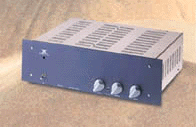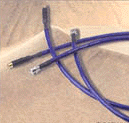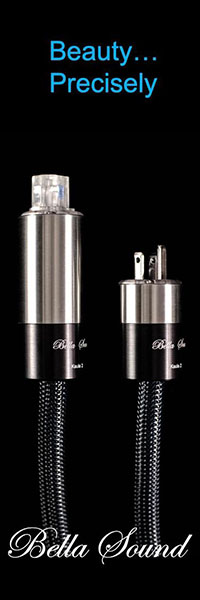Ensemble ECCO Integrated Amp and Cables
| Ensemble ECCO Integrated Amp and Cables |
|
Ensemble Fever |
|
Marshall Nack |
|
3 September 2000 |
ECCO Control amp with Powerflux power cord and Tubesox. Weight 33 lbs. $4750
ISOLINK Single outlet power conditioner. Weight 26 lbs. $1760
POWERPOINT 6 outlet AC distribution unit
with dedicated 2 m Powerflux PC $585
MEGA POWERPOINT 6 outlets with 2 m Mega Powerflux PC $980
POWERFLUX FSF Power cord 1.5meter $345
MEGA POWERFLUX Power cord 3meter $920, 2m $680
MEGAFLUX FSF Speaker cable 2 ½ meter $1430
$240 per additional ½ m. Biwire adds $75.
MASTERFLUX Interconnect 1m with Neutric RCA $460
HONEYPLATE Isolation platform with set of 4 spikes $395
16.9 X 12.6 X 1.6″(L W H)
TOPCONES Set of 7 isolation feet $90
Contact:
ARTISTIC AUDIO
Orange County, California, USA
Tel: 949-362-6080
E-mail: aaudio@home.com
Web: Ensemble
“The midrange was first rate, smooth, yet with natural dynamic scaling. The sound moved closer to neutral territory from the warm side, and remained musical. It was clear the ECCO was something out of the ordinary. This product line has what some English reviewers call rhythm and pace.”
You’ve heard the expression ‘Good things come in small packages.’ So it is with the Ensemble ECCO integrated amp. The ECCO arrived after I had submitted my review of the Impact Tech Vento 2000 speakers. I was using Ensemble wires throughout, including their AC products (POWERPOINT AC distribution unit and Powerflux PC), the Legend LAD L-1 pre- amp, and switching off among various power amps. The sound was good, but when I put the ECCO in things got considerably better. The bottom became fuller and more tuneful, treble became more extended, and the mids were as good as it had been with the separates. A little less bloom maybe, but not lean. The sound was not romantic or lush, but nimble, fast and dynamic, with an absence of artifact. As I found out later, in general these characteristics describe the overall Ensemble product line. In order of prominence, neutrality tops the list, followed by musicality and extended frequency response at both ends.
Background Check
Its founder incorporated ensemble as a Swiss company in 1986, Dr. Urs Wagner. This high-end boutique offers a complete line of audio components from AC conditioning, CD systems, amplification and vibration controls to a line of speakers, including home theatre gear. They are known in the states mostly for their Tubesox product, an anti- microphony tube damper. For a time, there was no American distributor, but now the line is again available in this country.
The Ensemble look is utilitarian, almost military, in appearance. While not expensive looking, it’s obviously high-end. It is functional, reliable and well made — straightforward, just like the sound.

Minus a mute control, the front panel of the ECCO is spare with a toggle on/off switch, a green power indicator light, and three rounded, dome-shaped knobs for Selector, Balance and Volume. The knobs look unmarked. Since I didn’t notice any detent or other indication for locating preferred settings, I was left to depend on the set screw on the bottom to gauge how loud the volume was set. Later on, a friend with better vision pointed out faint indicator lines. If I look closely, I can just make them out. Lightweight and compact at 35 pounds, the unit is just small enough to fit on a standard shelf.


The POWERFLUX PC POWERPOINT“employs star-configured parallel wiring (including star-grounding).” Most power strips are wired in series and transfer grunge all around. The manufacturer claims this parallel wiring design stops the propagation of audio pollution from one outlet to another.
The MEGA POWERPOINT power (6 outlet AC distribution) unit strip looks just like the standard one, but has a dedicated, top-of-the-line MEGA POWERFLUX PC and uses MEGA wiring internally.

MASTERFLUX interconnect terminations use high quality Neutric RCA jacks, while theMEGAFLUX FSF speaker wire terminations uses pure copper spades. The spades are small, which was a problem when used with the EAR amp — they didn’t fit around the binding posts. Also, the spades are somewhat thin and deform easily. The distributor says the spade choice was intentional because pure copper sounds better, even if it’s softer, and the smaller the contact area the better. I always thought a larger contact area is more desirable, but who knows? A larger spade termination is available on request.
Listening Impressions
As mentioned in the introduction, I had been using Ensemble wire with various component combinations. The Impact Technology Vento loudspeaker — Ensemble wire combo was synergistic. The wires extended the frequency response on both sides, and focused the stage. Especially in the upper treble there were new discriminations to be heard. I found that certain percussion instruments like triangle and tambourine cut through and rise above other treble instruments, like cymbals. Characteristically neutral and linear, they tend to get out of the way and don’t fatigue you with their own signature.
Then along came the ECCO and everything improved, yielding the best sound I heard from the Vents. It grabbed control of the bass with it’s 100 watts — making it tighter and more articulate. The sound stage became more dimensional, with more focused images, and layering front to back was more apparent. The treble became as extended as these speakers would ever go in my room — with clean, clear treble in frequencies beyond the other amps I tried. The midrange was first rate, smooth, yet with natural dynamic scaling. The sound moved closer to neutral territory from the warm side, and remained musical. It was clear the ECCO was something out of the ordinary. This product line has what some English reviewers call rhythm and pace. It gets the timing right. There was no grain to speak of. (Note: this is true of a lot of components that I’ve used lately. What used to be a pervasive problem has been remedied in many current designs.)
Fine source material sounded better than ever. For example, the early black label Vanguard LP of Stravinsky’s “Concerto in D for String Orchestra” with Edmund de Stoutz and the Zurich Chamber Orchestra (VSD 2112). This was an orchestra of virtuosi that studied only half a dozen pieces for an entire season. With this limited repertoire and given the caliber of musicianship, the recorded performance is technically flawless. In terms of style and clarity of execution, it is somewhat academic, but I give the recording 5 stars for sonic quality. What impresses me most is the weight of the massed strings and the energy of the attacks. The attacks were more aggressive and dramatic with the ECCO. It made me sit up and take notice. Some of these old black label Vanguards are well worth seeking out, especially the Utah Symphony discs led by Maurice Abravanel. Compare this to the splendid LP of Stravinsky’s work by the English Chamber Orchestra, led by the eminent Colin Davis (L’oiseau Lyre SOL 60050). This 1962 recording has long been a favorite of mine for the wonderful rendition of “Dumbarton Oaks” on the verso side. Terrific performance with great Decca sound from the early days, and very different from the Vanguard LP.
Magnepans and Tweaks
When my reference Maggies were back in place, the pendulum swung back drastically from dark to light — too light. First, I put three Airtight carbon/graphite blocks under the ECCO. These are the standard reference feet I use under most everything. The sound was quick and lively, but bright. The extension of the ECCO and the wires combined with the ribbon tweeter tilted the balance too much towards the top end. I got out my tweak box. I put some Shakti Onlines on the speaker wire on the amp side. There already were BYBEE filters on the wire going into the speaker side. Then I tried Vibrapods under the ECCO. The brightness was gone, but it was now a little dark. I was wondering what to try next when the HONEYPLATE isolation platform and a set of TOPCONES arrived. The combination of the HONEYPLATE with TOPCONES both under and over it is recommended for optimum isolation. Ensemble calls this the STILLOK System. But there was not height on my rack shelf for both the ECCO and the STILLOK system. So I used the TOPCONES alone under the ECCO, placing two in back and one in front, all pointing downwards. Voila! This got the balance just right. The brightness was gone, leaving the treble extended and in proportion. The bass got tighter, stage width was a little wider and more precise. Harmonics and overtones sounded spot on, without being overly warm, or lean for that matter. The music was dancing and vibrant.
Then the MEGA POWERPOINT arrived and replaced the standard POWERPOINT AC distribution unit. Also, two MEGA PC’s came in. These afforded improvements in increased body and dynamics, and resulted in a more involving presentation. The bass became tighter and more tuneful, and louder. The BEST BASS I’ve heard yet from the Magnepans. Mids were more liquid and smooth. Overall, the picture was less like a reproduction. Now we’re cookin.
How much of this change was due to the MEGA PC versus the contribution of the outlet strip? When I used the MEGA PC straight into an AC outlet with the Lingo power supply for the turntable there were all of the benefits noted above, plus even more treble extension and definition, more “bounce”. Connecting the PC to the MEGA POWERPOINT distribution unit resulted in less extension, but smoother treble. There was maybe less complexity on top, but on the other hand, it was easier to listen to. Some people will prefer this, it’s a matter of taste. Otherwise, the sound of the MEGA POWERPOINT and the MEGA PC are very close sonically.
To put things in perspective, using a passive outlet distributor and the superior MEGA PC’s handled my AC conditioning needs. The MEGA POWERPOINT, and PC are that good. You need some kind of outlet distributor for all those power cords to plug into. Consider that for $300 over the cost of a MEGA PC you get the MEGA POWERPOINT with its dedicated MEGA PC. This will take care of your conditioning needs and spread the noted benefits of the MEGA stuff to up to six components. It would be interesting to compare the MEGA POWERPOINT to some other conditioner — distributor in its price class, like a Chang Lightspeed or PS Audio Power Plant.
While the standard POWERFLUX PC is competitive in it’s price class, the MEGA POWERFLUX PC is a real contender at any price point. Depending on system synergies, it should be considered for use in the best systems.
Egglestonworks Rosa
Then the ROSA’s arrived (review to come) and the pendulum swung again, back to the warm side. It was very easy to voice these speakers once I got the beasts — 210 lbs. each — into my apartment! I just plopped them into the system with all the Ensemble gear and it clicked. There was an occasional boominess in the bass, and, with LP, an occasional breakup of loud treble passages, but with minimal compensatory placement adjustments, this combination left listeners captivated, and smiling.
I experimented with the ISOLINK AC Conditioner on and off throughout the review period. I found its benefits were marginal, until now. With the Rosa’s, I hooked the ISOLINK to the AHT phono pre-amp power supply and there was a definite improvement. It frees up the sound, letting the nuances flow. Overall, the sound became richer with more body and articulate bass. Now the ISOLINK stays connected all the time. The distributor says there would be even greater improvements if I used it with a digital front end. I did try it with my Music Hall CD32. Yes, I confess. I do have a CD player. Anyway, there was a vast improvement here, but remember this player retailed at around $300. Designed to condition only one component, the ISOLINK is very expensive at $1760. Potentially you will need more than one. I noted definite benefits with this configuration, but they came at a price.
Summing Up
You can see from my experience with 3 different speakers over the review period that system matching is unavoidable, as usual. The ECCO and wires mate excellently with dynamic speakers that tend to the warm side. The match with the Maggies was not made in heaven. I had to apply many tweak Band-Aids. For the Maggies, I would recommend a warmer amp, either solid state or tubed.
The ECCO being at the bottom of the Ensemble amplification lineup, and yielding such good performance, makes me wistfully ponder what delights await further, up the ladder. While not cheap, especially for an integrated amp, consider that the ECCO (MSRP $4750) replaced the Legend LAD-L1 pre-amp (MSRP $3000) and the BAT VK200 (MSRP $3500) with an overall superior sound. The Legend and the BAT were carefully selected from among competing products for their musicality. Both setups offer 100 watts per side. The ECCO surpassed this and every other amp that passed through during the review period. (The Legend pre-amp was constant during this time). The Stereophile Class-A rated integrated amps run from $2345 to $5200. Some of these even have built-in phono stages. But the most powerful is only 60 watts, and most are in the 40 watt range. This power level could not drive any of the speakers I had on hand and is a limitation I could not live with. I could live with the ECCO for the long haul.
Similarly, I found the wires to be very competitive within their price class. Individually, they were good sounding and good value. I would like to single out the MEGA POWERFLUX PC for its exceptional performance and recommend it for audition in the finest systems. Also, the MEGAFLUX FSF speaker cable is outstanding and should be considered in the top-tier offerings. With the arrival of the ECCO, things really came together. It is often the case that getting a full line of one manufacturer’s offerings produces an effect greater than the individual parts. If you go with the full line, you can’t go wrong: Otherwise, careful matching is in order, but no more than with any other boutique line.
Now, I wonder if I could get my hands on the cost-no-object ELYSIA loudspeaker?
![]()
Don’t forget to bookmark us! (CTRL-SHFT-D)
Stereo Times Masthead
Publisher/Founder
Clement Perry
Editor
Dave Thomas
Senior Editors
Frank Alles, Mike Girardi, Russell Lichter, Terry London, Moreno Mitchell, Paul Szabady, Bill Wells, Mike Wright, and Stephen Yan,
Current Contributors
David Abramson, Tim Barrall, Dave Allison, Ron Cook, Lewis Dardick, John Hoffman, Dan Secula, Don Shaulis, Greg Simmons, Eric Teh, Greg Voth, Richard Willie, Ed Van Winkle, Rob Dockery, Richard Doran, and Daveed Turek
Site Management Clement Perry
Ad Designer: Martin Perry





Be the first to comment on: Ensemble ECCO Integrated Amp and Cables